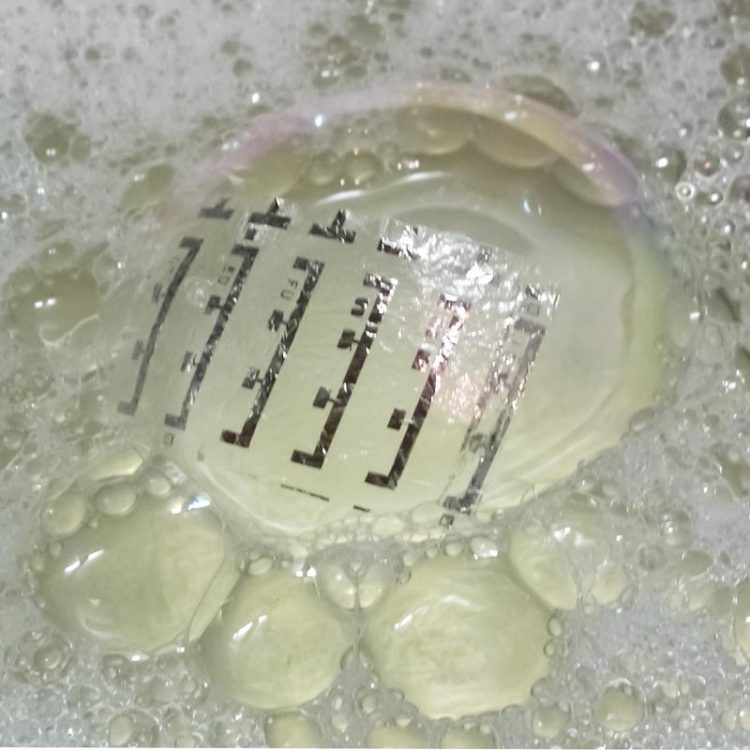Magnetic sense for everyone

The new magnetic sensors are light enough (three gram per square meter) to float on a soap bubble. Photo: IFW Dresden
Magnetoception is a sense which allows bacteria, insects and even vertebrates like birds and sharks to detect magnetic fields for orientation and navigation. Humans are however unable to perceive magnetic fields naturally.
Dr. Denys Makarov and his team have developed an electronic skin with a magneto-sensory system that equips the recipient with a “sixth sense” able to perceive the presence of static or dynamic magnetic fields. These novel magneto-electronics are less than two micrometers thick and weights only three gram per square meter; they can even float on a soap bubble.
The new magnetic sensors withstand extreme bending with radii of less than three micrometer, and survive crumpling like a piece of paper without sacrificing the sensor performance. On elastic supports like a rubber band, they can be stretched to more than 270 percent and for over 1,000 cycles without fatigue. These versatile features are imparted to the magnetoelectronic elements by their ultra-thin and –flexible, yet robust polymeric support.
“We have demonstrated an on-skin touch-less human-machine interaction platform, motion and displacement sensorics applicable for soft robots or functional medical implants as well as magnetic functionalities for electronics on the skin”, says Michael Melzer, the PhD student of the ERC group led by Denys Makarov concentrating on the realization of flexible and stretchable magnetoelectronics.
“These ultrathin magnetic sensors with extraordinary mechanical robustness are ideally suited to be wearable, yet unobtrusive and imperceptible for orientation and manipulation aids” adds Prof. Oliver G. Schmidt, who is the director of the Institute for Integrative Nanosciences at the IFW Dresden.
This work was carried out at the Leibniz Institute for Solid State and Materials Research (IFW Dresden) and the TU Chemnitz in close collaboration with partners at the University of Tokyo and Osaka University in Japan.
The original work was published in Nat. Commun. 6, 6080 (2015) http://www.nature.com/ncomms/2015/150121/ncomms7080/full/ncomms7080.html
Contact:
Dr. Denys Makarov,
Institute for Integrative Nanosciences
at Leibniz Institute for Solid State and Materials Research (IFW Dresden)
Germany
E-mail: d.makarov@ifw-dresden.de
Phone: +49 351 4659 648
Prof. Oliver G. Schmidt
Institute for Integrative Nanosciences
at Leibniz Institute for Solid State and Materials Research (IFW Dresden)
Germany
E-mail: o.schmidt@ifw-dresden.de
Phone: +49 351 4659 810
http://www.ifw-dresden.de/press-and-events/press-release/current-news/article/-6…
Media Contact
All latest news from the category: Materials Sciences
Materials management deals with the research, development, manufacturing and processing of raw and industrial materials. Key aspects here are biological and medical issues, which play an increasingly important role in this field.
innovations-report offers in-depth articles related to the development and application of materials and the structure and properties of new materials.
Newest articles

Properties of new materials for microchips
… can now be measured well. Reseachers of Delft University of Technology demonstrated measuring performance properties of ultrathin silicon membranes. Making ever smaller and more powerful chips requires new ultrathin…

Floating solar’s potential
… to support sustainable development by addressing climate, water, and energy goals holistically. A new study published this week in Nature Energy raises the potential for floating solar photovoltaics (FPV)…

Skyrmions move at record speeds
… a step towards the computing of the future. An international research team led by scientists from the CNRS1 has discovered that the magnetic nanobubbles2 known as skyrmions can be…





















